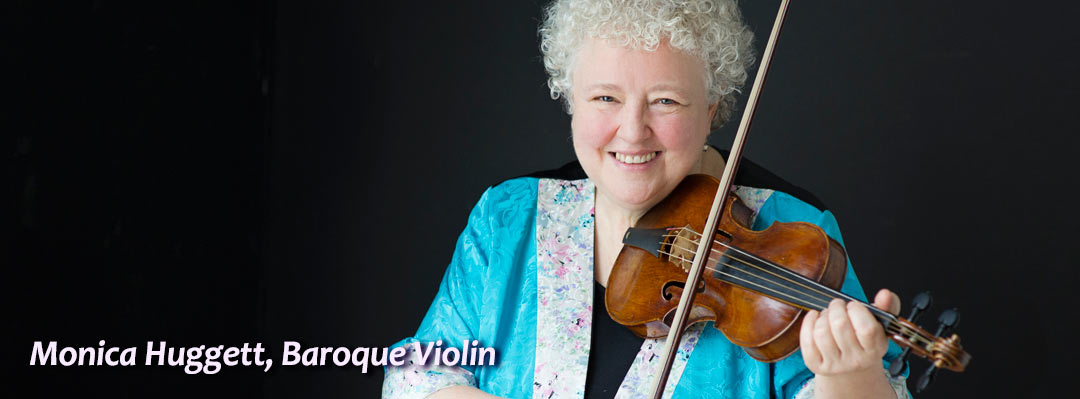Monica Huggett was born in West London the fifth of seven children into a culturally and ethnically Irish family. Her paternal grandmother was born in Ardee County Louth and her maternal grandmother, who was born in Paris, was named Germaine Sulliveaux and was the daughter of Ann Sullivan from Cork.
Monica’s paternal grandmother, Elizabeth Gargan, was a very strong character and very Catholic, and she had an enormous influence over the family, and that was the main source of why the Huggett family never felt quite English. Monica’s parents met in the choir of the local Catholic church, and music was very important to both of them. All seven children loved music, and several were quite talented. Monica’s mother was adamant that all her children would have music lessons. A half size violin had been given to the family by an uncle but no one was playing it. Monica came across it when she was six, and felt so sorry for the neglected instrument that she wanted to start learning it immediately. In those days kids were expected to learn to read music and learn to play at the same time, and that was something Monica found really difficult. She can still remember the first page of her first ever music book, and feeling so upset because she could not remember where to put her second finger. Most kids these days learn by the Suzuki method, where you learn to play the instrument first and learn to read music later, this is a much better system. It soon became clear that Monica was talented and then the pressure began! By the time Monica was twelve her parents and teachers had decided that she would be a musician, which meant she never had to go through the agony of deciding what to do with her life.
Although Monica was not a full-blown prodigy her talent was exceptional enough that she went to the Royal Academy of Music when she was 16. Her teacher, the eminent Armenian violinist Manoug Parikian, was not a very nurturing teacher, he was somewhat aloof. In the beginning she was very nervous in her lessons. She also found the conservatory system of training very far removed from the reality of being a musician. The reality of practicing six hours a day for four years and doing virtually nothing else was intellectually and spiritually impossible for her. Luckily something came along which made the whole experience real. From age 17 she started playing string quartets in The Pizza Express restaurants all over London. This was a useful source of income, and fantastic experience. The quartets were sourced from a whole network of musicians, you were never sure who was going to turn up to play. Here Monica made a huge number of important contacts in the professional world, which served her well as she developed her career. Very soon after going to the RAM she made her first contacts with people interested in historical performance. At that time students interested in early music were also interested in contemporary music, and Monica also spent a few years plaything in ensembles like Capricorn and The London Sinfonietta. By the time she was 19, although still a student, she was a member of the Musicians Union. It was a very exciting time, playing backing strings for the Rolling Stones on”Angie” playing on the first recording of the fledgling Academy of Ancient Music with Chris Hogwood, playing as extra in lots of chamber orchestras like the Bournemouth Sinfonietta and the Camden Chamber Orchestra, generally rushing around on her motorbike playing anything and everything.
Eventually the baroque violin won the battle for her heart, and in her mid twenties she gave up the modern violin for good.
In 1980 she was chosen by Ton Koopman to be the leader of his new orchestra “ The Amsterdam Baroque Orchestra”. Ton and Monica had an instant rapport, and he was the biggest musical influence in her life. Although the British baroque orchestras she had played with were successful, she never felt the same excitement about baroque music as she felt when listening to Eric Clapton play with The Cream. This always worried her and made her feel like she should have been a rock musician. Happily working with Ton Koopman changed all that. He had a way of grabbing the audience and pulling them into the drama of the music. This was revelatory for Monica, and suddenly her life made sense because she could communicate something spiritual and emotional to the audience.
Since then Monica had played with almost all the great musicians off the early music movement.
She had her own ensemble “Trio Sonnerie” for 25 years, and was also the first violinist of”Hausmusik” which was a ground-breaking ensemble playing classical and romantic music on period instruments, something Monica is still very interested in. In 2009 she was made the founding Artistic Director of the Historical Performance Program at The Juilliard School in New York, and was a member of the faculty until 2017. She is Artistic Director of the Portland Baroque Orchestra (USA) and Artistic Director Emerita of the Irish Baroque Orchestra.
